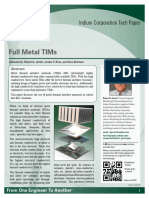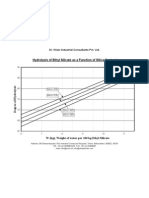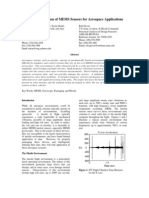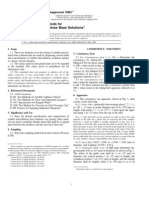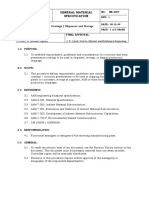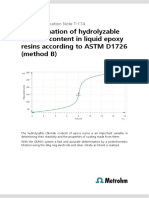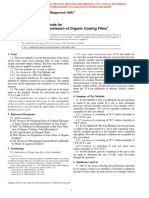Chlorine Water
Chlorine Water
Uploaded by
asfasfaCopyright:
Available Formats
Chlorine Water
Chlorine Water
Uploaded by
asfasfaCopyright
Available Formats
Share this document
Did you find this document useful?
Is this content inappropriate?
Copyright:
Available Formats
Chlorine Water
Chlorine Water
Uploaded by
asfasfaCopyright:
Available Formats
Degradation reported from laboratory testing of elastomer sheet materials subjected to
chloramines has not correlated to experience in the field for some applications. The effect
of chloramines, or any other chemicals, on elastomers in potable water systems is both
material-and-application specific. The large surface-area-to-mass exposure ratio of, for
BY RICHARD W. BONDS
example, toilet bowl flapper valves, is quite different from the small surface-area-to-mass
exposure ratio of ductile-iron pipe gaskets. To investigate this, side-by-side tests of elastomer
sheet materials and ductile-iron pipe push-on and mechanical joint gaskets exposed to
110 mg/L total chloramine solution were conducted. The push-on and mechanical joint
gaskets were tested in assembled joints. The tests, done over 364 days, revealed that
although the majority of the elastomer sheet materials experienced significant visual
degradation and large changes in mass, volume, and hardness, the ductile-iron pipe push-
on and mechanical joint gaskets showed no visual degradation and only slight detectable
chlorine penetration.
effect of Chloramines
on Ductile-iron Pipe Gaskets
of various elastomer
compounds
oday, disinfection of potable water systems normally is accomplished by
T maintaining a free chlorine (Cl2) or chloramine-combined residual.
Because of substantially lower disinfection efficiency, the combined
residual is commonly maintained at approximately 2 mg/L (total Cl2) in
the distribution system, compared with about 0.5 mg/L for the free Cl2.
Both chloramines and Cl2 are disinfectants that destroy potentially harmful bac-
teria should they enter the potable water system. Chloramine residuals are pro-
duced by combining Cl2 and ammonia. While the Cl2 element serves as a water
disinfectant, the ammonia serves to stabilize the Cl2. As a consequence, the Cl2
gas cannot escape, as it normally does, from water treated with Cl2 alone.
Chloramination is used by about 20% of municipal water treatment facilities
in the United States. Chloramines are a weaker disinfectant than Cl2, but are
more stable, thereby extending disinfectant benefits throughout a water utility’s
distribution system. For this reason chloramination provides better protection
against bacterial regrowth in systems with large storage tanks and dead-end
water mains.
2004 © American Water Works Association
BONDS | PEER-REVIEWED | 96:4 • JOURNAL AWWA | APRIL 2004 153
Research Foundation (AWWARF)
FIGURE 1 Large area-to-volume ratio exposure of elastomer sheetstock report Chloramine Effects on Distrib-
ution System Materials (AWWARF,
1993). A summary of the report states:
chloraminated compounds are signif-
icantly more aggressive to elastomers
than equivalent concentrations of free
chlorine. Results of the accelerated life-
Exposed area cycle testing support the anecdotal
of sheet material
(large surface-to-mass ratio) observations that elastomer failures
may, in some cases, be related to a
changeover from free chlorine disin-
fection to chloramination” (Reiber,
1993). The report also ranked elas-
tomer susceptibility to Cl2 attack as
follows: nitriles (NBR), styrene bu-
tadiene (SBR), natural rubbers, and
neoprenes (CR) as acutely sensitive;
FIGURE 2 Exposed area of mechanical joint gasket
ethylene-propylene (EPDM) and iso-
butyl-isoprene (IIR) as sensitive; and
Exposed area of mechanical joint fluorocarbons (FKM) and silicones as
gasket (small surface-to-mass ratio) least sensitive. From the AWWARF re-
port, it could be concluded that elas-
tomers commonly used as pipe gas-
kets, including NBR, SBR, CR, and
EPDM, are susceptible to detrimental
attack by chloramines.
In order to achieve accelerated
Mechanical joint—pipe 3–24 in. (76–610 mm), fittings 3–48 in. (76–1,219 mm) results, the AWWARF report was
based on the exposure of elastomer
sheetstock to tap water maintained
Compared to Cl2, chloramines produce lower levels of at 100oF (38oC) containing 300 mg/L of total combined
trihalomethanes (THMs), suspected carcinogens that form Cl2 for a period of 30 days. Such an exposure of sheet-
when Cl2 mixes with natural organic substances in water. stock results in a large area-to-volume ratio (Figure 1),
The promulgation of more stringent THM standards has just the opposite to that of push-on and mechanical joint
caused the industry to consider chloramination as a means ductile-iron pipe gaskets. Actual push-on and mechani-
of reducing THM production (AWWARF, 1993). Also, cal joint ductile-iron pipe gaskets have a small area
because chloramines are not as reactive as Cl 2 with exposed to the waterway in comparison to their total
organic compounds, taste and odor concerns are volume and mass (Figures 2 and 3). Although tests con-
decreased. ducted on sheetstock can be used to effectively rank elas-
Testing of sheet material. Earlier reports have suggested tomers, it would be inappropriate to use such tests in
that increased usage of chloramines has accelerated degra- an effort to establish pass/fail criteria for different elas-
dation of some elastomers common to distribution pip- tomer components. Each component is application-spe-
ing. One of the most recent of these was the AWWA cific (such as ductile-iron pipe gaskets) and therefore
FIGURE 3 Exposed area of push-on joint gasket
Exposed area of push-on joint
gasket (small surface-to-mass ratio)
†
Joint A*—3–24 in. (76–610 mm), joint B —4–36 in. (102–914 mm)
*TYTON® Joint, US Pipe and Foundry Co., Birmingham, Ala.
†FASTITE® Joint, American Cast Iron Pipe Co., Birmingham, Ala.
2004 © American Water Works Association
154 APRIL 2004 | JOURNAL AWWA • 96:4 | PEER-REVIEWED | BONDS
would require simulated testing FIGURE 4 Push-on joint sheet FIGURE 5 Mechanical joint sheet
of that component as it exists in material after 364 days material after 364 days
normal operation. of exposure of exposure
The American Society for Test-
ing and Materials developed a
national standard for ranking the
performance of elastomers sub-
jected to Cl 2 and chloramines
(ASTM, 1998a). D6284 covers
procedures for evaluating the abil- SBR 60 not immersed (control) SBR 75 not immersed (control)
ity of rubber and rubberlike mate-
rials to withstand the effects of
aqueous solutions with available
Cl2 and chloramines. The stan-
dard does not present pass/fail cri-
teria for elastomers. Its intent is to
establish a test procedure to com- SBR 60 immersed in chloramine solution
SBR 75 immersed in chloramine solution
pare the effects of Cl2 compounds
on different elastomers. The stan-
dard specifies a test involving
immersion of vulcanized sheets in
a solution of 50-mg/L total resid-
ual Cl 2 at 158 o F (70 o C) for Neoprene 65 immersed
22–4,366 h. This elevated tem- in chloramine solution
Neoprene 75 immersed
perature procedure does not lend in chloramine solution
itself to testing actual assembled
ductile-iron pipe joints and was
therefore not used.
Ductile-iron pipe gasket investi-
FKM 60 immersed in chloramine solution
gation. To evaluate ductile-iron
pipe gaskets exposed to chlor- FKM 75 immersed in chloramine solution
amines in actual service conditions
at the request of US Pipe and
Foundry Company, two SBR gas-
keted push-on joints were cut out SBR 60 immersed in distilled water
of St. Louis (Mo.) County Water
Company’s system in 1993 and SBR 75 immersed in distilled water
sent to them for evaluation.1 After
visual inspection, US Pipe and
Foundry Company forwarded the
gaskets to Akron Rubber Devel-
opment for physical testing.2 One
of the gaskets had been exposed
to chloramines for 26 years and Nitrile 75 immersed in chloramine solution
Nitrile 65 immersed in chloramine solution
the other for 28 years. Even after
extended exposure, the two SBR
gaskets had minimal visible imper-
fections on the surface of the nose
of the bulb in contact with the
chloraminated water. Additionally,
EPDM 75 immersed in chloramine solution
the physical test results were
within the minimum requirements
for new gaskets (ANSI/AWWA, EPDM 65 immersed in chloramine solution
1990). The condition of these two
gaskets suggested they were in the
EPDM—ethylene-propylene, FKM—fluorocarbons, SBR—styrene butadiene
early stages of their life cycles after
2004 © American Water Works Association
BONDS | PEER-REVIEWED | 96:4 • JOURNAL AWWA | APRIL 2004 155
subjected to chloramines and com-
FIGURE 6 Effect of chloramine on push-on joint gasket sheet material mass pare their performance with vulcan-
ized sheet material, side-by-side expo-
550 sure tests were initiated by the Ductile
SBR 60 (control) Iron Pipe Research Association July
SBR 60 14, 2000, and concluded on July 13,
450 NBR 65
CR 65 2001. Five gasket materials (SBR,
EPDM 65 EPDM, NBR, CR, and FKM) com-
Change in Mass—%
350 FKM 60
mercially available for both the push-
on and mechanical joint ductile-iron
250 pipe were tested. A simple exposure
test was selected in order to directly
compare the effect of chloramines on
150
sheet material to that of assembled
ductile-iron pipe joint gaskets.
50
DESCRIPTION
–50 Test specimens. Six 6 in. (150 mm)
0 50 100 150 200 250 300 diameter, cement mortar-lined, duc-
350 400
Exposure Time—days tile-iron pipe push-on joint sections
CR—neoprenes, EPDM—ethylene-propylene, FKM—fluorocarbons, NBR—nitriles, and six mechanical joint sections were
SBR—styrene butadiene
assembled in accordance with stan-
dard C600 (ANSI/AWWA, 1999)
FIGURE 7 Effect of chloramine on push-on joint gasket sheet material using approved gasket lubricant as
volume indicated by standard 61 (ANSI/NSF,
1999). Each joint section was approx-
650 imately 22 in. (550 mm) in length.
SBR 60 (control) Two sections of each type joint were
SBR 60
550 assembled utilizing SBR gaskets. The
NBR 65
CR 65 remaining four joint sections of each
450
EPDM 65 type joint were assembled using
FKM 60
Change in Volume—%
nitrile, neoprene, EPDM, and FKM
350
gaskets. 3 Representative 6 × 6 ×
0.080-in. (150 × 150 × 2-mm) vul-
canized sheets of elastomers were pre-
250
pared in accordance with standard
D3182 (ASTM, 1994). All elastomers
150
were sulfur cured. Standard 2 × 1 in.
(50 × 25 mm) test pieces (ASTM,
50
1998c) were cut from the vulcanized
sheets. Representative initial durom-
–50
0 50 100 150 200 250 300 350 400
eter hardness (type A), mass, and vol-
Exposure Time—days ume measurements were conducted
CR—neoprenes, EPDM—ethylene-propylene, FKM—fluorocarbons, NBR—nitriles, (ASTM, 1998a) on the test pieces
SBR—styrene butadiene before the test.
Also before testing, the joint sec-
tions were hydrostatically pressure-
tested to 250 psi (1723.7 kPa) for 1
26 and 28 years of service subjected to chloramines min, followed by an air test to 100 psi (689.5 kPa) for an
(Dunn, 1994). additional minute with no leakage. The pipe joint sec-
tions were then bedded on end in a shallow pan of epoxy4
DISCUSSION (a high-build, 100% solids epoxy free of solvent and ben-
The effect of chloramines on elastomers is applica- zyl-alcohol).
tion-specific. It cannot be concluded that pipe gaskets, Standard test solution. A sufficient amount of the chlor-
for example, are at risk by testing vulcanized sheets of elas- amine test solution composed of 10 L distilled water, 20 mL
tomers in the laboratory. In order to qualify pipe gaskets sodium hypochlorite (6% available Cl2), and 1.7 g of
2004 © American Water Works Association
156 APRIL 2004 | JOURNAL AWWA • 96:4 | PEER-REVIEWED | BONDS
ammonium sulfate (99.0% minimum)
was mixed at room temperature FIGURE 8 Effect of chloramine on push-on joint gasket sheet material
o
(73 F). The solution was continuously hardness
mixed for approximately 10 min and
then monitored for pH. If required, SBR 60 (control)
SBR 60
the pH was then adjusted to within NBR 65
the range of 5.5–6.5. Adjustments were CR 65
EPDM 65
accomplished using acetic acid to de- 5 FKM 60
crease the pH and ammonium acetate
0
to increase the pH with continuous
mixing. The finished solution had a
Change in Hardness—durometer*
–5
total Cl2 strength of approximately
–10
110 mg/L ± 10% as determined by a
high-range total Cl2 test kit.5 –15
The immersion period lasted 364
–20
days during which time the test solu-
tion was prepared and replaced –25
approximately twice a week. –30
Test conditions.
–35
• Chloramine test solution with
approximately 110 mg/L ± 10% to- –40
tal Cl2,
–45
• pH of 5.5–6.5, 0 50 100 150 200 250 300 350 400
• room temperature—73oF (23oC), Exposure Time—days
• test solution replaced approxi- CR—neoprenes, EPDM—ethylene-propylene, FKM—fluorocarbons, NBR—nitriles,
SBR—styrene butadiene
mately twice a week, and
• exposure period of 364 days. *Shore A durometer, Shore Instrument and Mfg. Co., Freeport, N.Y.
Test procedure. The pipe joint sec-
tions, except the control sections, FIGURE 9 Effect of chloramine on mechanical joint gasket sheet
were filled with the test water solution material mass
at room temperature. The control
550
pipe joint sections were filled with
SBR 75—control
distilled water. SBR 75
Three 2 × 1 × 0.08 in. (50 × 25 × 2 450 NBR 75
CR 75
mm) vulcanized sheet test pieces were EPDM 75
suspended in each pipe joint section
Change in Mass—%
350 FKM 75
with a minimum of 0.25 in. (6.3 mm)
separation. The pipe joint gasket elas- 250
tomers used in each assembled joint
corresponded to the elastomer test
150
sheet pieces suspended in that joint.
The test pieces were suspended using
nylon fishing line, which did not affect 50
the test solution or the elastomers.
The top of each pipe section was –50
0 50 100 150 200 250 300 350 400
covered with a glass plate and sealed
Exposure Time—days
with petroleum jelly.
CR—neoprenes, EPDM—ethylene-propylene, FKM—fluorocarbons, NBR—nitriles,
The vulcanized sheet test pieces SBR—styrene butadiene
were removed from the solution and
subjected to the following tests at
one- to two-week intervals during the entire 364 days (3) change in hardness determined in accordance with
of exposure: section 12 of standard D6284 (ASTM, 1998a).
(1) change in mass determined in accordance with sec- These tests are used for evaluating the ability of elas-
tion 10 of standard D6284 (ASTM, 1998a). tomer materials to withstand the effects of aqueous solu-
(2) change in volume determined in accordance with tions with available Cl2 and chloramines by assessing the
Section 11 of standard D6284 (ASTM, 1998a), and extent of water absorption.
2004 © American Water Works Association
BONDS | PEER-REVIEWED | 96:4 • JOURNAL AWWA | APRIL 2004 157
The surface appearance of the
immersed test pieces was visually
FIGURE 10 Effect of chloramine on mechanical joint gasket sheet material examined weekly for signs of pro-
volume gressive degradation and compared
with an unexposed test piece and
650
the control specimens. The immer-
SBR 75 (control)
SBR 75
sion sheet pieces and unexposed
550
NBR 75 sheet pieces were photographed
CR 75 weekly, and any change in the test
450 EPDM 75
Change in Volume—%
FKM 75 piece surfaces was recorded.
After the 364 days of exposure,
350
the pipe joint sections were hydrosta-
tically pressure tested to 250 psi
250
(1,723.7 kPa) for 1 min with no leaks
and then disassembled. A visual exam-
150 ination of the surface appearance of
the joint gaskets for signs of progres-
50 sive degradation compared with the
immersed test pieces was conducted.
–50 The joint gaskets were then pho-
0 50 100 150 200 250 300 350 400
Exposure Time—days tographed, and any changes in the
CR—neoprenes, EPDM—ethylene-propylene, FKM—fluorocarbons, NBR—nitriles, joint gasket surfaces were recorded.
SBR—styrene butadiene The 12 pipe joint gaskets were
then shipped to a lab2 for testing.
Physical testing included durome-
ter6 testing in accordance with stan-
FIGURE 11 Effect of chloramine on mechanical joint gasket sheet material dard D2240 (ASTM, 1997), tensile
hardness strength and elongation in accor-
dance with standard D412 (ASTM,
1998c), and compression set in
SBR 75 (control) accordance with standard D395,
SBR 75
NBR 75 method B (ASTM, 1998b)
CR 75 The lab also measured the depth of
EPDM 75
5
FKM 75
penetration of Cl2 (present in the
chloramine solution that was exposed
0
to the gasket surface) by Cl2 X-ray
–5 dot mapping. The dot mapping was
Change in Hardness—durometer*
accomplished using scanning electron
–10
microscope energy dispersive X-rays.
–15
RESULTS
–20
Vulcanized sheet test pieces. After
–25 364 days of exposure, the SBR con-
trol and FKM vulcanized sheet test
–30
pieces showed no visual degrada-
–35 tion and tests revealed very little
change in mass, volume, and hard-
–40
ness for both push-on and mechan-
–45 ical joint materials. All other elas-
0 50 100 150 200 250 300 350 400
Exposure Time—days
tomers showed significant visual
CR—neoprenes, EPDM—ethylene-propylene, FKM—fluorocarbons, NBR—nitriles,
degradation including swelling, curl-
SBR—styrene butadiene ing, and crumbling edges as shown
*Shore A durometer, Shore Instrument and Mfg. Co., Freeport, N.Y.
for push-on joint sheet test pieces in
Figure 4, and for mechanical joint
sheet test pieces in Figure 5. This
degradation was confirmed by phys-
2004 © American Water Works Association
158 APRIL 2004 | JOURNAL AWWA • 96:4 | PEER-REVIEWED | BONDS
ical measurements of change in mass,
volume, and hardness. The results of
TABLE 1 Sheet material results after 364 days of exposure
these measurements after 364 days of
exposure are reported in Table 1.
Change in mass and change in vol- Elastomer Sheet Change Change Change
ume are shown as a percentage gain Material* in Mass in Volume in Hardness
and Durometer % % units
relative to the specimens’ pre-expo-
sure measured mass and volume. The Push-on joint
change in hardness is shown as a SBR 60 (control†) 3 1 –3
change in durometer units relative to SBR 60 156 178 –21
the specimens’ pre-exposure hardness. NBR 65 511 592 –28
The increase in mass, increase in vol- CR 65 116 225 –38
ume, and change in hardness were as EPDM 65 392 414 –20
high as 511%, 592%, and –41 FKM 60 5 8 –2
durometer units, respectively. Time of Mechanical joint
exposure versus change in mass, SBR 75 (control†) 3 1 –3
change in volume, and change in SBR 75 156 189 –37
durometer are shown for push-on NBR 75 97 111 –14
joint sheet test pieces in Figures 6–8, CR 75 124 173 –41
and for mechanical joint sheet test EPDM 75 94 107 –16
pieces in Figures 9–11. FKM 75 7 11 –4
Overall, for the push-on joint vul- *SBR—styrene butadiene, NBR—nitrile, CR—neoprene, EPDM—ethylene-propylene, FKM—fluorocarbon
†SBR control test sheets were subjected to distilled water.
canized sheet test pieces subjected to
the chloramine solution, the perfor-
mance from best to worst was: FKM, TABLE 2 Summary of Cl2* penetration depth in gaskets exposed
SBR, CR, EPDM, and NBR. For the to chloramine by Cl2 X-ray dot mapping
mechanical joint vulcanized test pieces
subjected to the chloramine solution,
the performance from best to worst
Compound and Durometer Depth of Penetration—µm (in.)
was: FKM, EPDM, NBR, CR, and
SBR. The best performance was de- Push-on joint
fined as having the least overall change SBR 60 (control†) ND‡
in mass, volume, and hardness. SBR 60 28.2 (0.00111)
More important than the ratings NBR 65 28.2 (0.00111) and 32.7 (0.00129) when repeated
is the fact that the EPDM, NBR, CR, CR 65 ND
and SBR vulcanized sheet test pieces EPDM 65 7.6 (0.00030)
all showed significant degradation. FKM 60 ND
Because of slight inherent variations in Mechanical joint
the supplied raw materials, the chem- SBR 75 (control†) ND
ical composition of the same elas- SBR 75 ND
tomer compounds vary from manu- NBR 75 27.6 (0.00109)
facturer to manufacturer and also CR 75 ND
within a single manufacturer’s opera- EPDM 75 ND
tion. Elastomers obtained from sup- FKM 75 ND
pliers other than the one used in this *Cl2—chlorine, SBR—styrene butadiene, NBR—nitrile, CR—neoprene, EPDM—ethylene-
study3 or from the same supplier at propylene, FKM—fluorocarbon
†SBR control gaskets were subjected to distilled water.
an earlier or later date may result in a ‡ND—not detected
different order of rating from best to
worst when tested. However, any
EPDM, NBR, CR, or SBR vulcanized
sheet material would be expected to result in significant revealed that all the gaskets’ mechanical properties exceeded
degradation when subjected to the identical testing the requirements for new gaskets (ANSI/AWWA, 1990).
reported here. Results of Cl2 penetration depth tests are reported
Push-on and mechanical joint gaskets. None of the push- in Table 2. Only the SBR 60, NBR 65, EPDM 65, and
on or mechanical joint gaskets showed any visual degra- NBR 75 showed detectable depths of Cl2 penetration.
dation after the joint sections were disassembled. Testing also Even after exposure to extreme concentrations of chlor-
2004 © American Water Works Association
BONDS | PEER-REVIEWED | 96:4 • JOURNAL AWWA | APRIL 2004 159
amines, these reported depths were shallow. Assuming systems will not compromise the life of SBR, NBR, CR,
a linear Cl2 penetration versus time relation, after 100 EPDM, or FKM elastomer gaskets supplied with push-on
years of exposure to approximately 110 mg/L ± 10% and mechanical joint ductile-iron pipe.
total Cl2, the gaskets would experience 2.82 mm (0.111 Exposure tests of vulcanized sheet materials are not
in.), 3.27 mm (0.129 in.), 0.76 mm (0.030 in.), and 2.76 relevant to pipe gaskets. The performance of pipe gaskets
mm (0.109 in.) of penetration, respectively. Again, as- and other uses of elastomers are application-specific.
suming a linear Cl2 penetration versus time relation, a Future research to supplement this work may include
normal distribution system’s total Cl2 concentration of investigation of the effect of additional variables, differ-
2 mg/L would result in only 51.27 µm (0.00202 in.), ent elastomer formulations, curing methods, field studies,
59.45 µm (0.00235 in.), 13.85 µm (0.00055 in.), and and/or utility surveys of performance history.
50.18 µm (0.00198 in.) Cl2 penetration, respectively,
after 100 years of exposure. ABOUT THE AUTHOR:
For the past 18 years, Richard W. Bonds has been
CONCLUSION research and technical director of the Ductile Iron Pipe
After 354 days of exposure to 110-mg/L ± 10% chlor- Research Assn., 245 Riverchase Pkwy. East, Ste. O,
amine solution, the SBR, NBR, CR, and EPDM vulcan- Birmingham, AL 35244; e-mail
ized sheet test pieces showed significant visual degrada- rbonds@dipra.org. He is a multistate
tion including swelling, curling, and crumbling edges. registered professional engineer
Physical measurements also showed large changes in mass, and a NACE international corrosion
volume, and hardness. specialist. He is a member of AWWA,
National Association of Corrosion
Engineers, National Fire Protection
Because of slight inherent variations in the Association, and American Standards
for Testing and Materials. Bonds received his bachelor’s
supplied raw materials, the chemical composition degree from Auburn University and his master’s degree
from the University of Alabama–Birmingham.
of the same elastomer compounds vary from
manufacturer to manufacturer and also within a FOOTNOTES
1US Pipe and Foundry Co., Birmingham, Ala.
2Akron Rubber Development Laboratories Inc., Akron, Ohio.
single manufacturer’s operation. 3Specification
Rubber Products Inc., Pelham, Ala.
4Mainstay DS–5, Madewell Products Corp., Alpharetta, Ga.
5High Range Chlorine Test Kit Model CN-21P, Hach Co., Loveland Colo.
6Shore 4 durometer, Shore Instrument and Mfg. Co., Freeport, N.Y.
Actual assembled push-on and mechanical joint duc-
tile-iron pipe sections subjected to the same exposure
showed no visual degradation of the gaskets and only
slight detectable Cl2 penetration of SBR 60, NBR 65,
If you have a comment about this article,
EPDM 65, and NBR 75.
please contact us at journal@awwa.org.
On the basis of these tests, utilities can be assured that
the use of chloramines for disinfection in potable water
REFERENCES rine and Chloramine. D11.40.13, West for Mixing Standard Compounds and
Conshohocken, Pa. Preparing Standard Vulcanized Sheets.
ANSI (American National Standards Insti-
West Conshohocken, Pa.
tute)/AWWA, 1999. C600: Installation of ASTM, 1998b. D395, Method B. Test Methods
Ductile-Iron Water Mains and Their for Rubber Property—Compression Set. AWWARF (AWWA Research Foundation),
Appurtenances. West Conshohocken, Pa. 1993. Chloramine Effects on Distribution
ANSI/AWWA, 1990. C111/A21.11: Rubber-Gas- ASTM, 1998c. D412. Test Methods for Vulcan- Systems Materials. AWWA Res. Fdn.,
keted Joints for Ductile-Iron Pressure ized Rubber and Thermoplastic Rubbers Denver.
Pipe and Fittings. and Thermoplastic Elastomers—Tension. Dunn, L.R., 1994. Internal Report From
West Conshohocken, Pa. US Pipe and Foundry Co. to
ANSI/NSF, 1999. Standard 61: Drinking Water
System Components—Health Effects. ASTM, 1997. D2240. Test Method for Rubber F.D. Larson, St. Louis County
Property—Durometer Hardness. West Water Co.
ASTM (American Society for Testing and
Conshohocken, Pa. Reiber, S., 1993. Investigating the Effects of
Manufacturing), 1998a. D6284. Test
Method for Rubber Property—Effect of ASTM, 1994. D3182. Practice for Rubber— Chloramine on Elastomer Degradation.
Aqueous Solutions With Available Chlo- Materials, Equipment, and Procedures Jour. AWWA, 85:8:101.
2004 © American Water Works Association
160 APRIL 2004 | JOURNAL AWWA • 96:4 | PEER-REVIEWED | BONDS
You might also like
- The Ever Flowing Fountain PDFDocument11 pagesThe Ever Flowing Fountain PDFAnonymous QsaZweZV100% (2)
- Catalogue Indium CorporationDocument5 pagesCatalogue Indium CorporationPhilippe GuillemetNo ratings yet
- 521+technical Data Sheet V-6Document2 pages521+technical Data Sheet V-6TeenTeen GaMingNo ratings yet
- Sartocheck 5 Plus Filter Datasheet en B Spi2020 Sartorius DataDocument10 pagesSartocheck 5 Plus Filter Datasheet en B Spi2020 Sartorius DataAli FıratNo ratings yet
- ISO - 2177 - EN. Coulometric TestDocument8 pagesISO - 2177 - EN. Coulometric TestSathyaraj M SNo ratings yet
- A Comparison of Laboratory Abrasion and Field Wear ResultsDocument11 pagesA Comparison of Laboratory Abrasion and Field Wear ResultschrisnnnNo ratings yet
- Abrasion Resistance of Iron-Based Hardfacing AlloysDocument10 pagesAbrasion Resistance of Iron-Based Hardfacing AlloysRolando Mario Nuñez MonrroyNo ratings yet
- Refractory Datasheet 1 - KORUNDAL XDDocument1 pageRefractory Datasheet 1 - KORUNDAL XDSubrata DasNo ratings yet
- Surlon KE Datasheet Hard Ceramic Hard Anodizing With Lubrication 29AUG17Document8 pagesSurlon KE Datasheet Hard Ceramic Hard Anodizing With Lubrication 29AUG17Giacomo ZammattioNo ratings yet
- B343 92a Reapproved 2014 PDFDocument3 pagesB343 92a Reapproved 2014 PDFNinad PawarNo ratings yet
- NORSOK Recommended-Guidelines-For-Water-Based-Firefighting-SystemsDocument17 pagesNORSOK Recommended-Guidelines-For-Water-Based-Firefighting-SystemsG0% (1)
- 2011 H2 Chemistry Paper 1 Suggested SolutionsDocument18 pages2011 H2 Chemistry Paper 1 Suggested SolutionsLee Jun HuiNo ratings yet
- Enclosed Carbon-Arc Exposure Tests of Paint and Related CoatingsDocument6 pagesEnclosed Carbon-Arc Exposure Tests of Paint and Related CoatingsProvocateur SamaraNo ratings yet
- Dow Thermal MaterialsDocument16 pagesDow Thermal MaterialsRudyXPNo ratings yet
- Astm D2765 - 2011Document7 pagesAstm D2765 - 2011sh.jahanyar.apcNo ratings yet
- Csir NML Training Deepak PDFDocument26 pagesCsir NML Training Deepak PDFAnabiya NoorNo ratings yet
- A 268 Â " A 268M Â " 04 QTI2OC9BMJY4TQDocument6 pagesA 268 Â " A 268M Â " 04 QTI2OC9BMJY4TQCynthia GutierrezNo ratings yet
- ASTM D 1141 - 98 (Reapproved 2003) Standard Practice For The Preparation of Substitute Ocean WaterDocument3 pagesASTM D 1141 - 98 (Reapproved 2003) Standard Practice For The Preparation of Substitute Ocean Watershekhar2307No ratings yet
- The Preparation of Substitute Ocean Water: Standard Practice ForDocument3 pagesThe Preparation of Substitute Ocean Water: Standard Practice ForAbid HussainNo ratings yet
- Treatment of An Anodizing Waste To Water Quality-Based Effluent LimitsDocument6 pagesTreatment of An Anodizing Waste To Water Quality-Based Effluent LimitsbaneNo ratings yet
- Ethyl Silicate Hydrolysis ChartDocument1 pageEthyl Silicate Hydrolysis ChartDr. Vikhar KhanNo ratings yet
- ASTM D2228 04 - Standard Test Method For Rubber Property-Relative Abrasion Resistance by Pico Abrader MethodDocument9 pagesASTM D2228 04 - Standard Test Method For Rubber Property-Relative Abrasion Resistance by Pico Abrader MethodAndre Rodriguez Spirim100% (1)
- Determining The High Stress Abrasion Resistance of Hard MaterialsDocument6 pagesDetermining The High Stress Abrasion Resistance of Hard MaterialsHadi HowaidaNo ratings yet
- Effect of Chlorine Vs Chloramine Treatment Techniques On Materials Degradation in Reclamation InfrastructureDocument19 pagesEffect of Chlorine Vs Chloramine Treatment Techniques On Materials Degradation in Reclamation InfrastructureprakashNo ratings yet
- Vibration Isolation of Mems Sensors For Aerospace ApplicationsDocument5 pagesVibration Isolation of Mems Sensors For Aerospace ApplicationsPedro SkouNo ratings yet
- Astm D365Document3 pagesAstm D365Frank LeeNo ratings yet
- MS-4037 - Rev - BDocument5 pagesMS-4037 - Rev - BEngenharia APedroNo ratings yet
- Plastic Material SpecificationsDocument3 pagesPlastic Material Specificationskg_selvarajNo ratings yet
- Magnesium-Alloy Sheet and Plate: Standard Specification ForDocument6 pagesMagnesium-Alloy Sheet and Plate: Standard Specification ForDanZel DanNo ratings yet
- GM Visual Acceptance Crtieria For WheelsDocument25 pagesGM Visual Acceptance Crtieria For WheelsVinod Vindy KrishnaNo ratings yet
- Silicone Rubber Compounds, Curing Agent Dicumyl Peroxide, 40-75 Shore A, Q, Peroxide Cure (M 608 - 5 DCP)Document2 pagesSilicone Rubber Compounds, Curing Agent Dicumyl Peroxide, 40-75 Shore A, Q, Peroxide Cure (M 608 - 5 DCP)sunitaNo ratings yet
- Congealing Point of Petroleum Waxes, Including Petrolatum: Standard Test Method ForDocument3 pagesCongealing Point of Petroleum Waxes, Including Petrolatum: Standard Test Method ForahmedNo ratings yet
- SECCO S2040: Polypropylene, HomopolymerDocument2 pagesSECCO S2040: Polypropylene, HomopolymerManuel Lopez100% (2)
- Characterization of Zircon-Based Slurries For Investment CastingDocument10 pagesCharacterization of Zircon-Based Slurries For Investment CastingNarasimha Murthy InampudiNo ratings yet
- Astm d1726Document2 pagesAstm d1726ubaid_nedianNo ratings yet
- Method For Mercurous Nitrate Test For Copper I and Copper Alloys (Document4 pagesMethod For Mercurous Nitrate Test For Copper I and Copper Alloys (Mukesh kumarNo ratings yet
- Iso 5085 1 1989Document9 pagesIso 5085 1 1989Zeeshan KhanNo ratings yet
- Astm B555-86 (2018)Document5 pagesAstm B555-86 (2018)Reshan Viduranga100% (1)
- Bronze-Base Powder Metallurgy (PM) Bearings (Oil-Impregnated)Document22 pagesBronze-Base Powder Metallurgy (PM) Bearings (Oil-Impregnated)RizwanNo ratings yet
- EN 13655-2002 - enDocument20 pagesEN 13655-2002 - enJimmys GothiqueNo ratings yet
- Chemical Analysis of Copper-Nickel and Copper-Nickel-Zinc AlloysDocument7 pagesChemical Analysis of Copper-Nickel and Copper-Nickel-Zinc Alloysaiurea92No ratings yet
- E1010 16 PDFDocument4 pagesE1010 16 PDFFrancisco PizarroNo ratings yet
- Astm D5402 (2019)Document2 pagesAstm D5402 (2019)uziNo ratings yet
- ASME IIC SFA5.3 - AlDocument14 pagesASME IIC SFA5.3 - AltragaldabasNo ratings yet
- ASTM D610-08 (Reaaproved 2019) Standard Practice For Evaluating Degree of Rusting On Painted Steel SurfacesDocument6 pagesASTM D610-08 (Reaaproved 2019) Standard Practice For Evaluating Degree of Rusting On Painted Steel SurfacesSwaminathan BoopathiNo ratings yet
- Araldite Klad XDocument1 pageAraldite Klad XakhanNo ratings yet
- Fiberglass Reinforced Styrene-Butadiene-Styrene (SBS) Modified Bituminous Sheets With A Factory Applied Metal SurfaceDocument3 pagesFiberglass Reinforced Styrene-Butadiene-Styrene (SBS) Modified Bituminous Sheets With A Factory Applied Metal SurfaceKevin Josue100% (1)
- ASTM D-7490-13 (Contact Angle)Document5 pagesASTM D-7490-13 (Contact Angle)T Aaa0% (1)
- Nitoflor SL1000: Flow Applied, 0.5 - 1.5mm Thick Epoxy Resin Based Floor Topping UsesDocument4 pagesNitoflor SL1000: Flow Applied, 0.5 - 1.5mm Thick Epoxy Resin Based Floor Topping UsestalatzahoorNo ratings yet
- Adequacy of Fusion of Extruded Poly (Vinyl Chloride) (PVC) Pipe and Molded Fittings by Acetone ImmersionDocument3 pagesAdequacy of Fusion of Extruded Poly (Vinyl Chloride) (PVC) Pipe and Molded Fittings by Acetone ImmersionAndres Camilo BenitezNo ratings yet
- Renderoc La80Document4 pagesRenderoc La80talatzahoorNo ratings yet
- ILNAS-EN ISO 604:2003: Plastics - Determination of Compressive Properties (ISO 604:2002)Document7 pagesILNAS-EN ISO 604:2003: Plastics - Determination of Compressive Properties (ISO 604:2002)Analista2 laecolNo ratings yet
- BS en Iso 12004-1 - 2008Document16 pagesBS en Iso 12004-1 - 2008Institute of Marketing & Training ALGERIANo ratings yet
- Bitumen Use in Electrical InsulationDocument6 pagesBitumen Use in Electrical Insulationsamar209No ratings yet
- Datasheet BH3910 Impactpp eDocument1 pageDatasheet BH3910 Impactpp eEmre UzunogluNo ratings yet
- Astm B 480 - 88 R01Document3 pagesAstm B 480 - 88 R01SamuelNo ratings yet
- Astm D1005-1995 Rev 2020Document3 pagesAstm D1005-1995 Rev 2020jose reyNo ratings yet
- OMAE2017-61555: Corrosion Fatigue Mechanisms and Fracture Mechanics Based Modelling For Subsea Pipeline SteelsDocument11 pagesOMAE2017-61555: Corrosion Fatigue Mechanisms and Fracture Mechanics Based Modelling For Subsea Pipeline SteelsArab WeldersNo ratings yet
- d1653 Water Vapor Transmission of Organic Coating Films1Document5 pagesd1653 Water Vapor Transmission of Organic Coating Films1caronieblesNo ratings yet
- The Iron Oxides: Structure, Properties, Reactions, Occurrences and UsesFrom EverandThe Iron Oxides: Structure, Properties, Reactions, Occurrences and UsesRating: 5 out of 5 stars5/5 (1)
- Combined Chlorine Dissipation Pipe Material, Water Quality, and Hydraulic EffectsDocument11 pagesCombined Chlorine Dissipation Pipe Material, Water Quality, and Hydraulic EffectsCharith JayawickramaNo ratings yet
- Proceso Excavacion MasivaDocument11 pagesProceso Excavacion MasivaBrandom Rydber ArcanaNo ratings yet
- Grundfosliterature 5616937Document10 pagesGrundfosliterature 5616937SrikanthNo ratings yet
- Prime SP Bleach Fix Working SolutionDocument7 pagesPrime SP Bleach Fix Working SolutionelsokukabaNo ratings yet
- Organic Compounds With Description and ExamplesDocument21 pagesOrganic Compounds With Description and ExamplesMikah SubaNo ratings yet
- Step 4: Selecting Materials To Be Recovered.: Add Tipask QuestioncommentdownloadDocument4 pagesStep 4: Selecting Materials To Be Recovered.: Add Tipask QuestioncommentdownloadkeethanNo ratings yet
- Daniela Botus - Sani-Test. Quality ManagementDocument9 pagesDaniela Botus - Sani-Test. Quality ManagementInstitutul PasteurNo ratings yet
- Pasay GC2 Q3 W2 03 Day 3Document5 pagesPasay GC2 Q3 W2 03 Day 3KairuuuNo ratings yet
- TCP - IDocument35 pagesTCP - IPrashant GauravNo ratings yet
- 750-0020 Seawaterecbiofouling Sept15Document8 pages750-0020 Seawaterecbiofouling Sept15Recep VatanseverNo ratings yet
- Amiad Water Systems LTD.: 3" Spin Klin Battery External Source Automatic Back-FlushDocument31 pagesAmiad Water Systems LTD.: 3" Spin Klin Battery External Source Automatic Back-Flushdani JuandaNo ratings yet
- 9 Antifouling SystemDocument24 pages9 Antifouling SystemYuri DuriNo ratings yet
- Topical Application of Antibiotics in Primary Teeth PDFDocument10 pagesTopical Application of Antibiotics in Primary Teeth PDFenimaNo ratings yet
- Branson Ultrasonic Cleaner 2510 PDFDocument36 pagesBranson Ultrasonic Cleaner 2510 PDFShrikant PandeyNo ratings yet
- Chapter ThreeDocument20 pagesChapter ThreeKasozi Bateesa ShafickNo ratings yet
- IrigasiDocument21 pagesIrigasiFatimah DewiNo ratings yet
- Colour Chronicle: A Clariant Chemicals (India) Limited Publication For Textile, Leather and PaperDocument20 pagesColour Chronicle: A Clariant Chemicals (India) Limited Publication For Textile, Leather and Paper950 911No ratings yet
- 4 - Common Acids and Alkalis (Pp2)Document10 pages4 - Common Acids and Alkalis (Pp2)api-3700944100% (1)
- Bleaching With Green Oxidation ChemistryDocument5 pagesBleaching With Green Oxidation ChemistrygatotgNo ratings yet
- Double 3 2010Document18 pagesDouble 3 2010moyowamichelleNo ratings yet
- Answers For Group VII Problem-Solving QuestionsDocument9 pagesAnswers For Group VII Problem-Solving QuestionsTan Song Kai100% (1)
- Copper As A Biocidal Tool: Gadi Borkow and Jeffrey GabbayDocument13 pagesCopper As A Biocidal Tool: Gadi Borkow and Jeffrey GabbayxxrreisNo ratings yet
- AOCS Cc3 - 25 Punto de Fusion Capilar AbiertoDocument4 pagesAOCS Cc3 - 25 Punto de Fusion Capilar AbiertoLilianRuizNo ratings yet
- AMPC Training Final Report PDFDocument36 pagesAMPC Training Final Report PDFIbrahim Al-HammadiNo ratings yet
- Textile Wet Processing UNIT-2Document5 pagesTextile Wet Processing UNIT-2Chaarvi SaranyaNo ratings yet
- Dulcotest Dt1B Photometer: Operating ManualDocument52 pagesDulcotest Dt1B Photometer: Operating ManualrudiNo ratings yet
- Aspectsof Clinical Malpracticein EndodonticsDocument9 pagesAspectsof Clinical Malpracticein EndodonticsMihaela TuculinaNo ratings yet
- Continuous Production Electrochlorinator Sea - Water - Based PDFDocument4 pagesContinuous Production Electrochlorinator Sea - Water - Based PDFdubaisrinivasuluNo ratings yet

